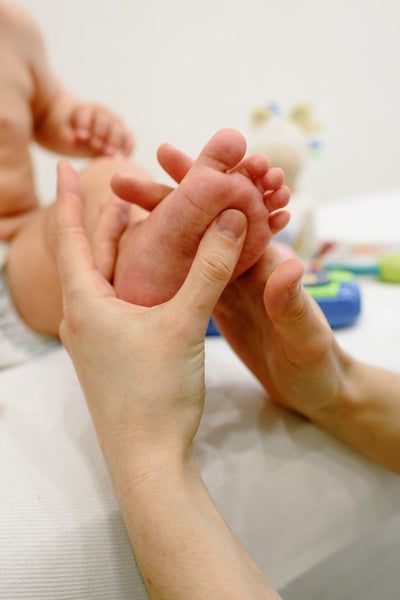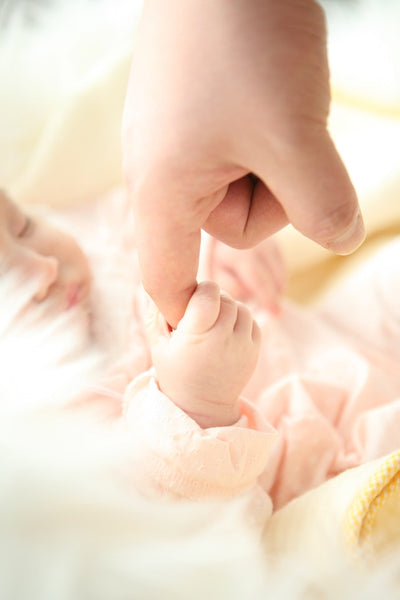8 Fascinating Reflexes to Look for in Your Newborn

Newborn reflexes are automatic, instinctive actions that a baby demonstrates in response to certain stimuli. From opening their mouth to curling their toes, infants are naturally designed to produce specific, involuntary muscle reactions. While reflexes in newborn babies are precious to observe, they actually serve an evolutionary purpose. They’re built into the human DNA structure because they helped infants survive over time. Historically, possessing these natural responses may have been key to a baby’s survival past infancy.
Why Newborn Reflexes Are Important
Newborn reflexes are normal, expected muscle reactions in babies. Many of these responses are present before the baby is even born. They’re not something an infant has control over but instead develop within the brainstem and are connected to early development. They aid your baby’s transition to life outside the womb and help them learn what they need to do to survive. Your pediatrician will observe these newborn reflexes as they evaluate your baby’s health. The existence and intensity of their instinctive responses are keys to understanding your little one’s nervous system function and development.
A collection of baby bath time favorites, the Mustela Bath Time Essentials Set includes 4 critical, plant-based skin care products to keep your baby clean and moisturized during and in-between baths.

Mustela Bath Time Essentials Set
Types of Newborn Reflexes
Here are a few reflexes of newborn babies you can watch for in your little one. Some reflexes will stay with your baby for months, while others fade away in a matter of weeks:
1. Tonic neck reflex or “fencing posture”
When your baby is lying on their back, the tonic neck reflex, also known as the fencing posture, should manifest. By turning your baby's head to one side, their arm on that same side should extend straight, with their hand partially open. Conversely, their opposite arm should flex and bend, forming a tight fist. This position resembles that of a fencer, hence the term "fencer's posture."
2. Sucking reflex
The sucking reflex is an important survival instinct. When you stimulate your infant's mouth or introduce a nipple, they should instinctively start sucking. While this reflex is innate, it can be challenging. Your newborn needs to learn how to coordinate sucking, breathing, and swallowing simultaneously.
3. Stepping reflex
The stepping reflex plays a role in guiding a newborn to instinctively move towards the breast shortly after birth while lying on its mother’s chest. When the baby's feet touch a flat surface, they may exhibit stepping movements. If the baby is held in an upright position with their soles allowed to touch the surface, they should alternately move one foot in front of the other, mimicking a walking motion.

4. Rooting reflex
The root reflex, also known as the rooting reflex, is another fundamental survival instinct. It aids your baby in locating and attaching to a nipple for feeding. By gently stroking your baby's cheek or mouth, they should instinctively turn their head towards your hand. They will then open their mouth and initiate sucking motions.
5. Moro reflex or “startle reflex”
The newborn startle reflex, also known as the Moro reflex, acts as a defensive reaction to unexpected movements or loud noises. If your infant’s head suddenly falls backward or they’re surprised by an unexpected noise, they should react by spreading out their arms and legs. They will extend their arms with palms facing upward, while their thumbs may stick out. Loud crying may occur as well. Once you provide support to their head again, they should promptly bring their arms together and settle.
6. Babinski reflex
The Babinski reflex in newborn babies is observable when you stroke the bottom of your infant’s foot from heel to toe. Their big toe will flex upward while their remaining toes fan out.

7. Plantar grasp reflex
As the Babinski reflex fades, it is eventually replaced by the plantar grasp, another instinctive response. You can observe this response by placing a finger below your little one's toes and watching their toes curl around it.
8. Palmar grasp reflex
The palmar grasp reflex enables babies to grip objects. When you touch the palm of your baby's hand, their fingers will naturally curl around and tightly grasp your finger. If you attempt to remove your finger, their grip will tighten even more. This reflex eventually aids in the development of intentional grasping skills in infants.

When Do Newborn Reflexes Go Away?
The majority of newborn reflexes typically fade away between the ages of four to six months. As your baby's brain and central nervous system develop, these involuntary reflexes are gradually replaced by deliberate, voluntary movements. The Moro and stepping reflexes tend to fade by around 2 months of age, while the grasping and tonic neck reflexes may persist for a bit longer. However, by your baby's first birthday, all newborn reflexes should be gone entirely. You can see a newborn reflexes chart from the American Academy of Pediatrics for a general idea of what to expect.
Do Any Newborn Reflexes Stick Around?
While many newborn reflexes fade shortly after birth, some reflexes stick around through adulthood. These reflexes include:
- Gag reflex: Sputtering or choking when the back of your mouth or throat is touched.
- Sneeze reflex: Sneezing when the inside of your nose is irritated.
- Cough reflex: Coughing when the back of your airway is stimulated.
- Yawn reflex: Yawning when your body requires additional oxygen.
- Blink reflex: Blinking when you are exposed to bright light.
The Takeaway on Newborn Reflexes
As soon as they’re born, your little one possesses an innate repertoire of reflexes designed to aid their survival during the initial stages of life. The pediatrician will assess these reflexes to ensure their presence and strength. As your baby grows older, some of these reflexes will naturally fade away as they acquire new abilities and become more independent. It's important to note that each baby follows their own developmental timeline, and the timing of when these reflexes emerge and disappear can vary. If you have any concerns regarding your baby's development, it is advisable to consult with your child's healthcare provider.
Disclaimer: The information on our site is NOT medical advice for any specific person or condition. It is only meant as general information. Please contact your health provider if you have any medical questions or concerns about your child or yourself.









